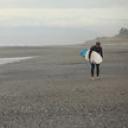Southerly pulses the main source of surf
Eastern Tasmania Surf Forecast by Guy Dixon (issued Monday 28th March)
Best Days: Thursday
Recap:
Saturday morning saw a good window of northwesterly winds in the morning, with options filling in at around 2-3ft. Sunday saw more size out of the south with sets in the 3-4ft range, although hampered by southerly breezes, tending northeasterly later.
Today, the surf dialled back to the 2-3ft range, remaining clean during the morning under a northwesterly breeze.
This week (Tuesday 29th - Friday 1st):
Easterly swell is on a downward trend, fading from the 1-2ft range this afternoon, further on Tuesday.
Southerly swell will become the prime source of surf in the coming days however, with small pulses generated by southwesterly fetches trailing a series of frontal progressions.
South facing beaches should see sets fade from the 2ft+ range, further from the 2ft range on Wednesday.
Early northwesterly breezes should lead to clean conditions each morning, giving way to a seabreeze later.
A low pressure trough looks to deepen over the mainland throughout Tuesday, before moving offshore on Wednesday with an embedded low expected to develop within. A northeasterly fetch located along the eastern flanks of this developing system looks to increase while moving across the Tasman.
As a result of this fetch increasing in intensity and becoming more elongated, east/northeasterly energy looks to build to a peak on Thursday with options in the 2-3ft range, limited only by less than ideal alignment.
Thursday looks to remain clean for the majority of the day, with northwesterly breezes persisting into the afternoon.
This weekend (Saturday 2nd - Sunday 3rd):
A gutsy southwesterly change is due to move over the region on Saturday, with a local southerly windswell building in its wake. South facing beaches have the potential to build to the 2ft range at exposed locations, with the westerly component and rapid nature once again limiting swell generation.
Due to the local nature of the swell generating winds, quality is likely to be low, with protected spots seeing virtually no size.
Each swell window then looks to quieten down as a result of poorly aligned frontal activity.

